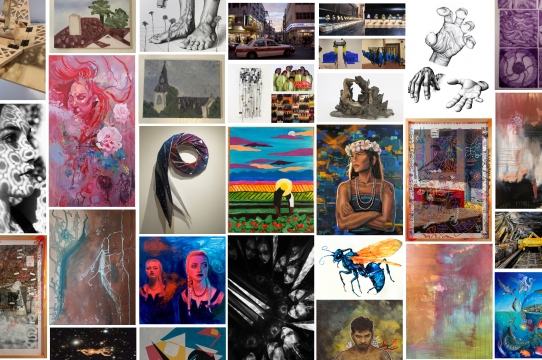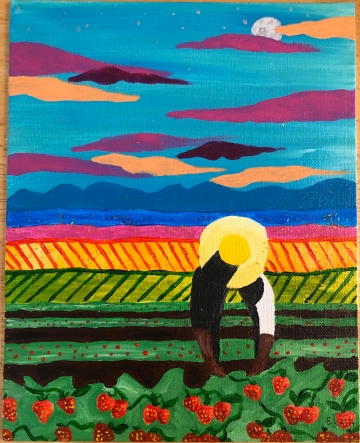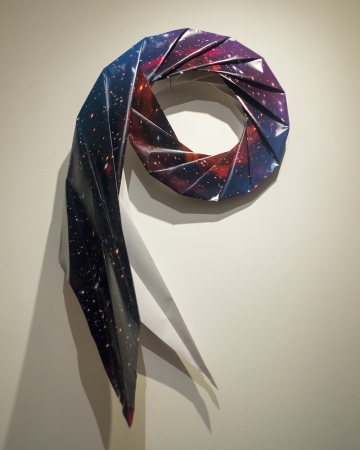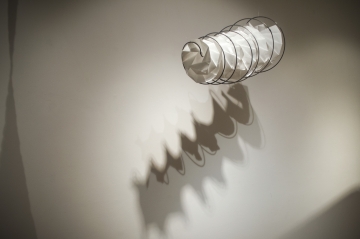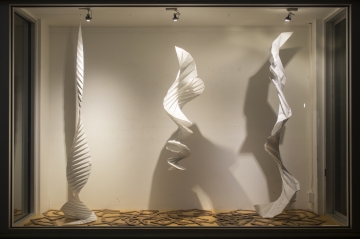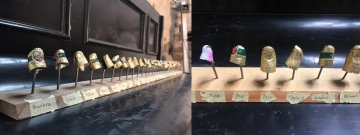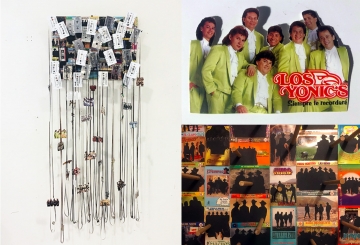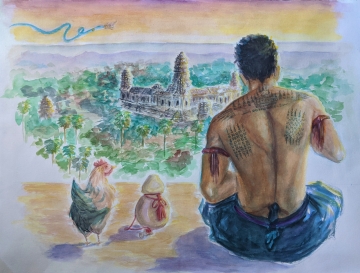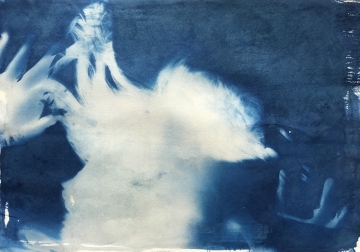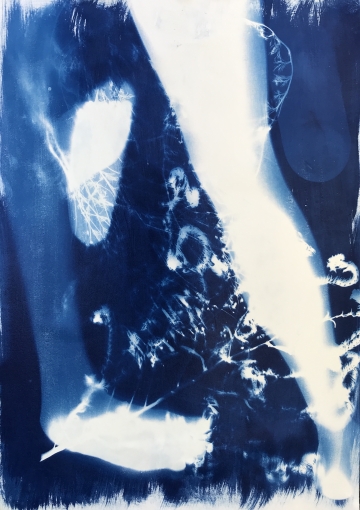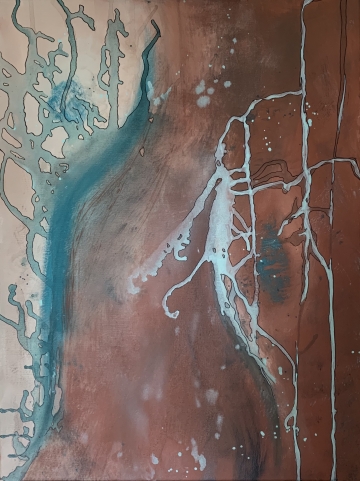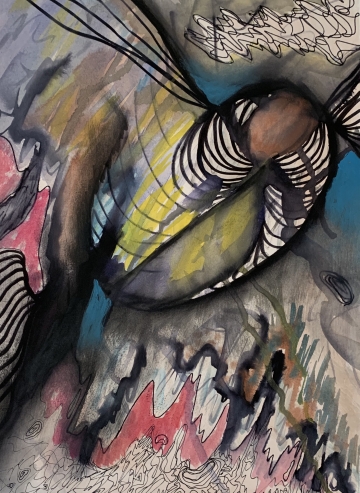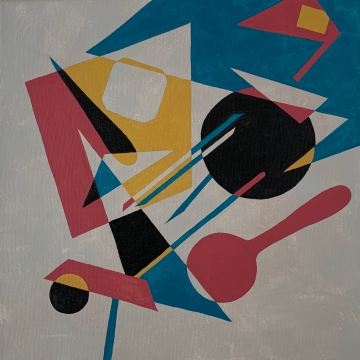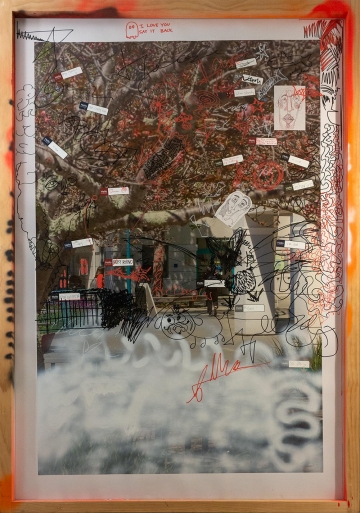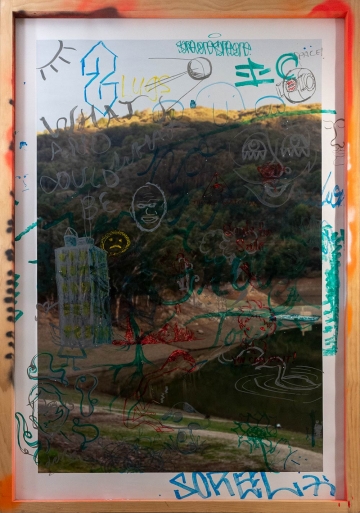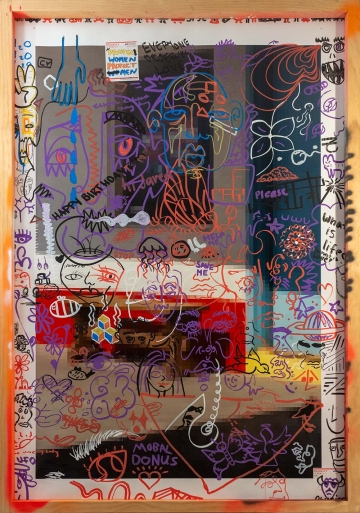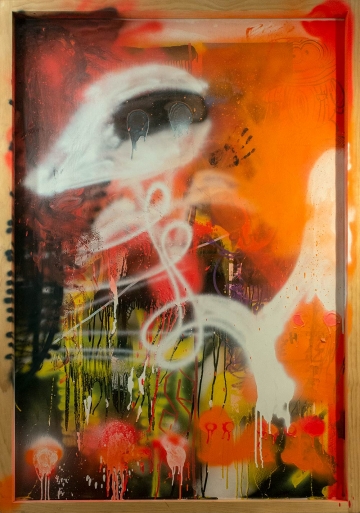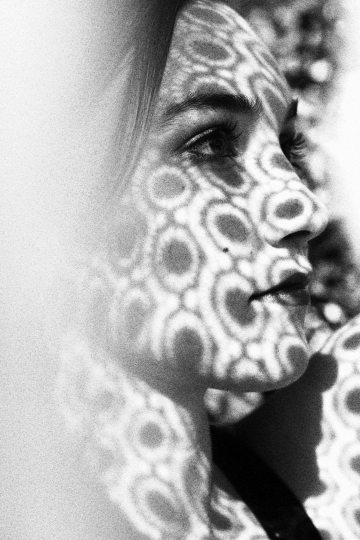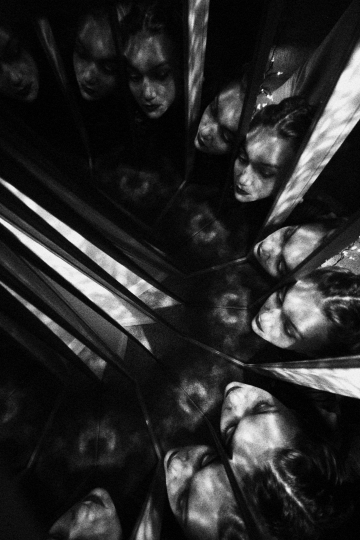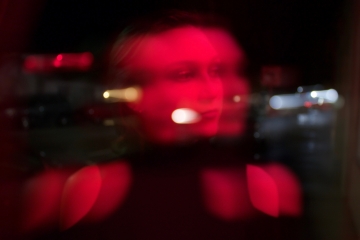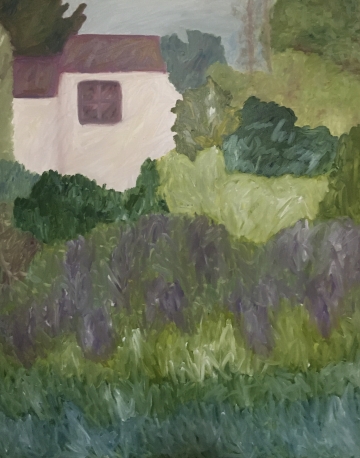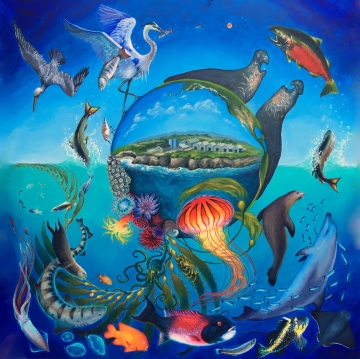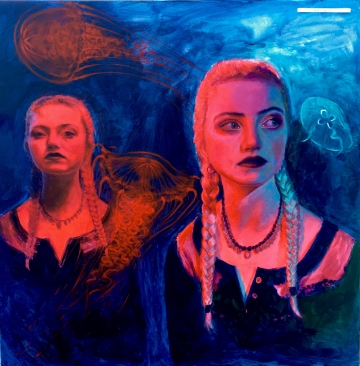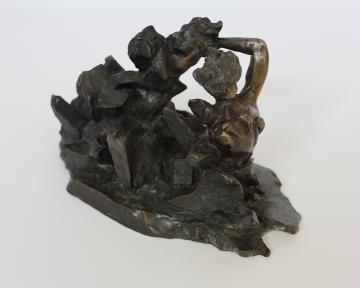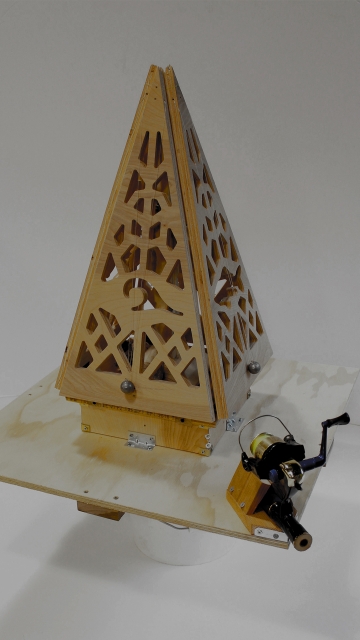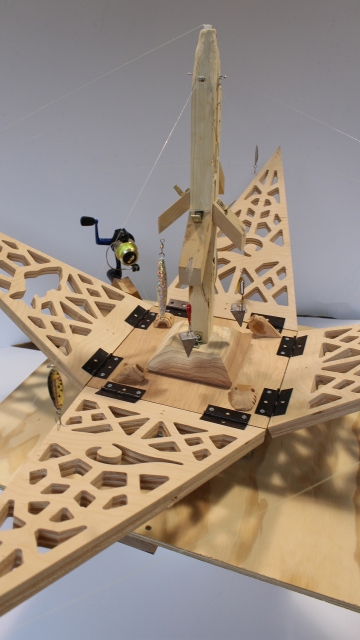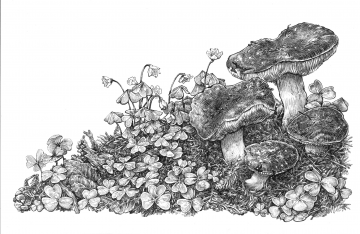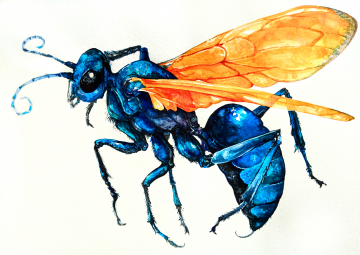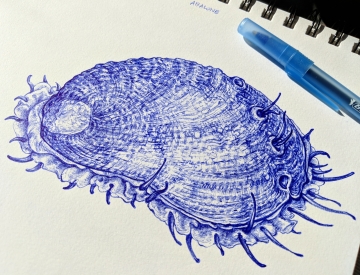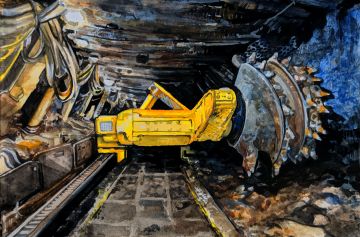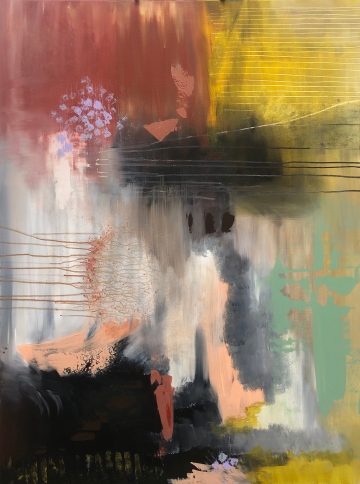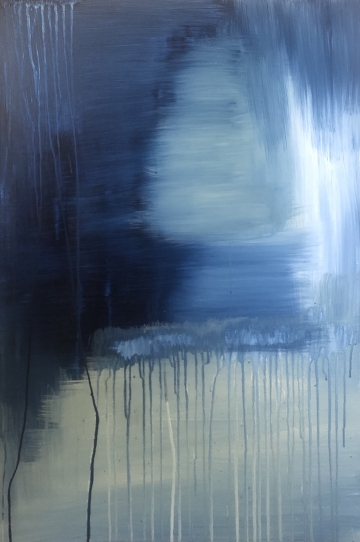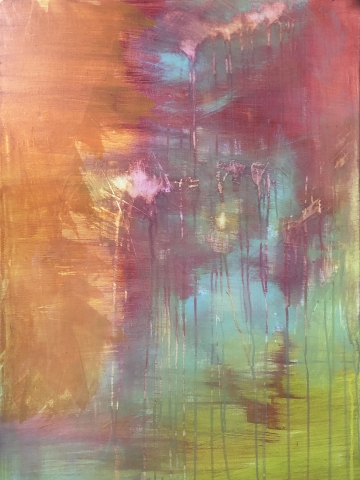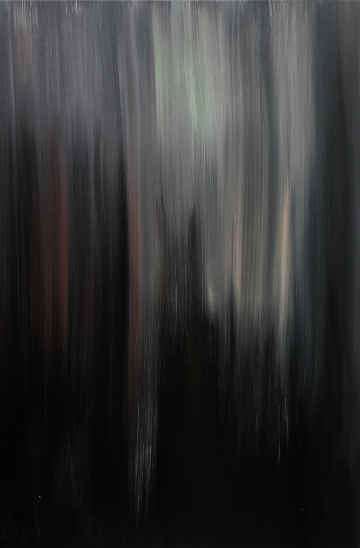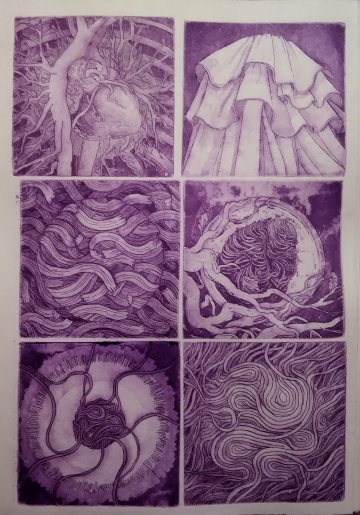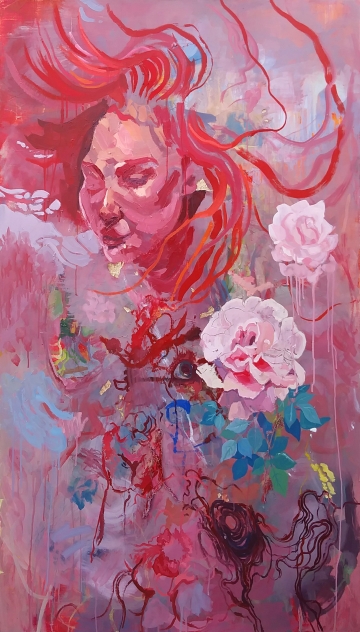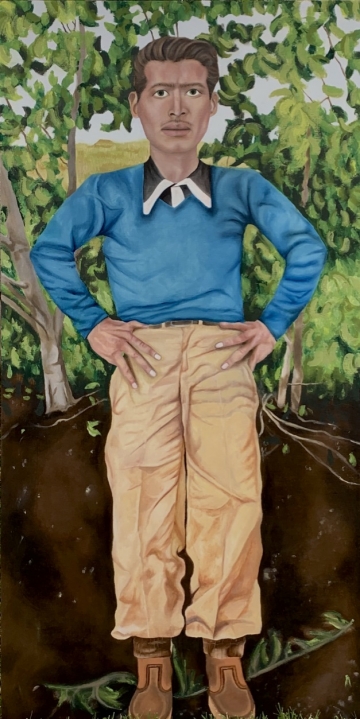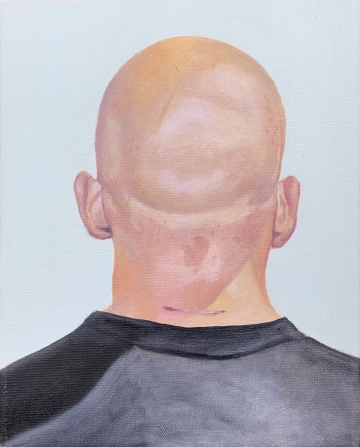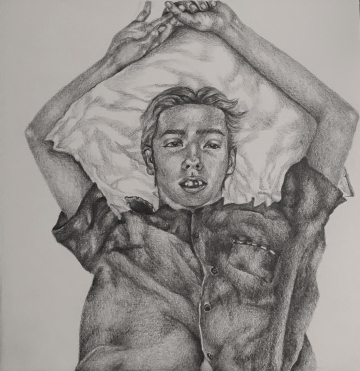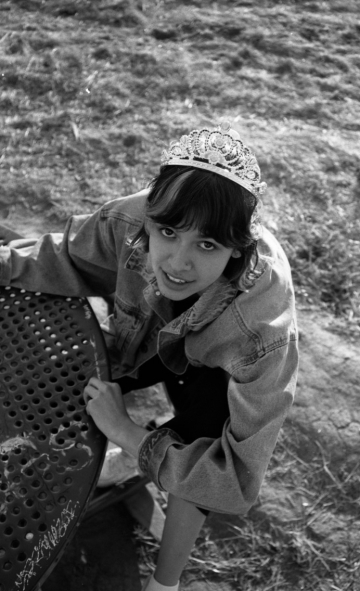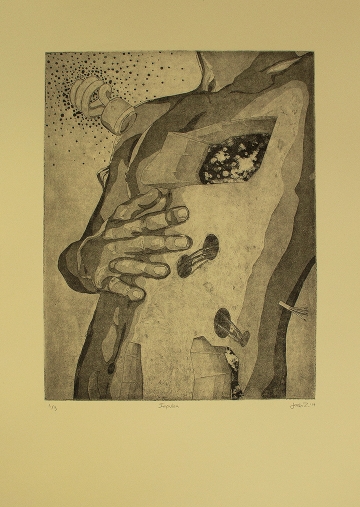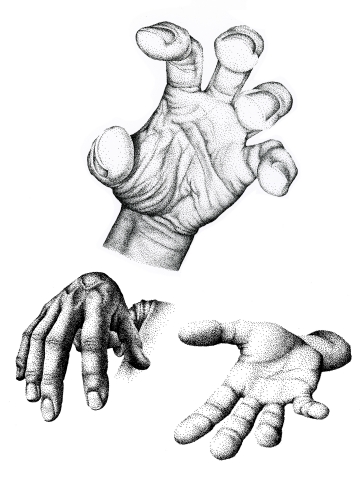Eduardo Carrillo Virtual Group Show 2020
The Eduardo Carrillo Scholarship, established in 1997 in memory of UC Santa Cruz Art Professor Emeritus and famed Chicano muralist Eduardo Carrillo, is awarded to the most talented emerging student-artists in the Art Department. Since its inception, the scholarship has benefited over 300 students.
In celebration of Eduardo Carrillo's life, the 2020 scholarship recipients, and the importance of teaching art and fostering creativity, the Art Department is proud to welcome you to the Eduardo Carrillo Scholarship Virtual Group Show. Due to the difficulties of these times, not all of the Carrillo Scholars were able to submit their artworks so we would like to mention all of their names here:
2020 Eduardo Carrillo Scholars:
- Claire Apana
- Emily Aranda
- Veriche Blackwell
- Sarah Bun
- Christian Cortez
- Edgar Cruz
- Vanessa Divittorio
- JaredGuzman
- Cindy Hernandez Contreras
- Davidra Jackson
- Nina McCue
- Cam Mckay
- Willow Moseley
- Jose Rojas Dimas
- Nina Scherer
- Stephanie Segur
- Morgan Tomfohr
- Andrea Vidales
- Joshua Zupan
Sincerest gratitude to Alison Keeler Carrillo for her generosity in establishing the Eduardo Carrillo Scholarship, and for her deep-seated commitment to education which has had an enormously positive impact on the lives of countless students, encouraging them to experiment with art and explore the depths of their creativity.
Thank you to Betsy Andersen, Director, Museo Eduardo Carrillo, for her unfailing commitment to art, education, and the Carrillo Scholarship Recipients – both present and past.
Museo Carrillo information: To learn more about the life and art of Eduardo Carrillo visit museoeduardocarrillo.org
Please watch the captivating and touching documentary about Eduardo Carrillo titled A Life of Engagement:
2020 VIRTUAL GROUP SHOW:
Emily Aranda
I am a fourth-year art student at UCSC. During my time at UCSC, I have mostly focused on printmaking. However, I have included two paintings and two photographs. My two paintings are both acrylic paintings and I wanted the theme to focus on the importance of essential workers. One of the paintings is of my father, who works at a milk manufacturing company in Sacramento. The other is of migrant farmworkers and their importance. In both of the paintings, I wanted to honor these people. Continually, I like my art to work around social justice issues. Both of my photographs were taken in Okinawa, Japan. I had gone there to do work for the undergraduate research project, The Okinawa Memories Initiative. I wanted my photos to represent the beautiful island that I was staying on. Okinawa has so much color and vibrant life and through my photographs, I wanted to emphasize that.
1. "Peter Aranda," Acrylic on Canvas, 8"x10", 2020. This painting honors my father, who is a hard worker at Hood, a milk manufacturing company. This painting is fun and playful, as I try to capture the personality of my dad and all of his happiness.
2. "Thank You Essential Workers," Acrylic on Canvas, 8"x10", 2020. This painting celebrates migrant farm workers. The bright colors show an early morning sky, emphasizing how early they have to get to the fields.
3. "Kokusaidori Street." 2019. Digital Photograph. This photograph captures the new, vibrant city life that has grown on the island.
4. "Okinawa, Japan." 2019. Digital Photograph. This photograph was taken to capture the beauty of the island, which surrounds a person at all times. All of the beauty and nature might seem overwhelming but not in a bad way.
Claire Apana
As a child, I was obsessed with origami as it was a means of exploring my asian heritage through art. I was mesmerized by the look and feel of origami papers and found it fascinating that I had the ability to create delicate works of art with a readily available material. My passion for beautiful papers followed me into my career in photography.
My works focus on the concept of Impossible Realities: Paradoxical ways of life that are absolute. Through our actions we are able to inspire change. Previous installations have included a combination of medias in order to convey a nuanced sense of experience. Photography, videography, sound sculptures, paintings, sculpture, and performance create a unique environment for the viewer.
Recent works consist of performances in which I hand fold massive photographs into sculptures. By integrating origami patterns onto a traditionally two dimensional medium, I am able to create a complex and dimensional photographic sculptures. In manipulating the raw material, I reconstruct the narrative into a new form. Through collective action and solidarity we can contain the chaos around us in order to design stability for all. My art practice is a way of taking control by means of creation.
Image 1: Controlling Chaos. Structural Photography (sculpture). 2019, 50” x 30” x 10”. This photograph utilizes imagery from the Hubble Space Telescope; in controlling the chaos within our universe, we are able to create order within our lives.
Image 2: Duality. Sculpture: Paper and metal. 2019, 24” x 15” x 15”. This sculpture utilizes contrasting materials in order to create tension. This is expressive of our own anxieties; of being delicate, of being trapped, of floating in limbo.
Image 3: Falling for You. Video Still (Projection). 2018, 120” x 120”. Falling for You is a video projection that encapsulates the allure and entrapment that societies have created within their cities. This video expresses the conflict of wanting and rejection, longing and belonging, admiration and repulsion.
Image 4: 2020 Phases. Sculpture: Paper and masonite. 2020, 72” x 96” x 24”. These paper forms are made of the same material, yet vary depending on their manipulations, thus mirroring our own changes and developments that we endure throughout life.
Veriche Blackwell
As an artist, sociological scholarship is my muse, and as a sociologist, my art practice is my research. I have always been fascinated and perplexed by the ways our society affects individual experience; the ways social constructs impose on individual lives. As a queer person of color, born to an immigrant single mother I learned first hand how systems can constrict the composition of lives, how individuals are seen and shaped through social judgements. I’m interested in creative ways to fight back against monolithic institutions, ways to survive. My artwork unpacks the inner workings of our society in order to imagine and strive toward a more equitable and compassionate future. My work looks at presence and absence, allowing the viewer to consider the role of the individual within a society - how and why individual experiences differ and coincide.
1. “A Transitory Experience” (2019) Metal rod, ¼” MDF, webbing, vinyl, nuts and screws. 11” x 45” x 9”. This piece transforms a moment which is often overlooked into a spectacle to be honored and enjoyed. Furthermore, “A Transitory Experience” urges the viewer to reevaluate the ways in which they engage with their surroundings and community.
2. “Water is Life” (2019) Found vessels, tables, tablecloths, wood, water. 3’ x 9’ x 4’. This piece explores issues of class, environmental racism, and access.
3. “Can I borrow you for a moment?” (2019) Foil, wood, nails, tape, ink. 4’ x 2.5” x 3.5”. At Artmill Center for Sustainable Creativity my peers and I would walk home and relax by sharing beers. Using the foil from those bottles, I held hands with everyone while delicately molding foil to their thumbs, memorializing the small moment of fleeting intimacy.
4. “Exploited and Displaced” (2017) Cassette tapes, MDF wood, wooden dowels, black construction paper. 2.5’ x 1.5’ x 5’. Created during the Trump administration during increases in violent administrative acts against undocumented people this piece aims to highlight the injustice in the culture surrounding immigrants in the United States. Sadly, three years later this piece remains relevant.
Sarah Bun
The series of works I’ve been in the process of creating is a commemoration to my Khmer culture and preserving its beauty & history. Painting myself by creating other characters that pertain around a different cultural aspect such as dance, religion, community and etc. through each portrait is the goal thus far. This is also a way for me to personally get in touch with my ancestral side. My Cambodian & Thai roots are embedded into my portrait paintings, providing a closer look into my community and inviting the viewer to enjoy my culture with me.
Image 1. “Sak Yant”, Acrylic on Canvas, 18” x 24”, 2019. A portrait of a tattoo master of sak yant, an ancient khmer tattoo tradition that is said to bring protection, strength & magic among its bearer.
Image 2. “Temple View”, Watercolor on Coldpress, 22” x 30”, 2020. A wanderer and his chicken companion overlook one of many temple ruins in Cambodia.
Image 3. “Cali Cambo”, Acrylic on Canvas, 22” x 28”, 2020. A painting of a happy Cambodia/Thai-Californian fella enjoying TLC New Year.
Image 4. “Bunong”, Acrylic on Canvas, 22” x 28”, 2020. A portrait of a Bunong tribeswoman. The Bunong are an indigenous group of subsistence farmers who live in the highlands of Cambodia.
Edgar Cruz
My time during this worldwide pandemic has been fortunate with space, time, and resources to continue my artistic work. Historically, my work has always examined the relationship between people and the self. But throughout the past couple months, the experience of physical touch, human connection, and intimacy have changed. Losing the physicality of friendships and hangouts has resulted in feeling friendless. Now I am observing who I have strong connections with and who's willing to maintain those connections.
This current body of work consists of photograms made through the cyanotype process. I am very fortunate that the cyanotype process is very simple and easy to do at home. All you need is affordable cyanotype chemistry, paper to coat the chemistry on, and some direct sunlight. The process is simple: coat, expose, and wash with water. This untitled body of work involves me exposing my body onto the paper via the sun. Prints 1-2 involve me exposing my head, hair and arms onto the paper, while 3-4 involves two individuals legs and feet. I am deeply interested in this performative process. I am thinking about how unavailable physical human contact is today, while also thinking about how our ideas/views of human connection are changing through this pandemic.
1. Cyanotype, 22" x 15", April 2020. I am exposing my head, hair, and arms onto the UV light sensitive paper. This print explores the permeability of light through my hair. Multiple exposures are created using the movement of my body during the 8 minute exposure.
2. Cyanotype, 22" x 15", April 2020. I am laying my head sideways onto the paper, as if my cheeks are glued to the print. The composition of my head is sort of disorienting in that there are no clear recognizable facial features.
3. Cyanotype, 20" x 27", April 2020. Exploring the relationship between plant and human bodies, I utilize human legs and feet in combination with plant specimens I’ve been collecting. I am constantly experimenting with depth of shadows, impressions, and physical bodies.
4. Cyanotype, 20" x 27", April 2020. Another experimentation with the exposure of skins. The physical touch between these different bodies is important in thinking about our relationships and connections to other beings.
Vanessa DiVittorio
The passion I feel for abstract art (mostly painting) arose during a time of feeling constricted. It was a form of escapism and now I mostly paint with pure imagination and very little emotion. Abstract art is not bound by the real. There can be no representation of something, it can simply be what it is: a painting. I have found my art to be increasingly gender neutral over time. My go to color palette are colors like red-oxide, oceanic teal, light tan, and burnt sienna. These exuberate, earthly, oceanic tones are harmonious together, creating a welcoming space. There is love in the details of my paintings. Often there are elements of line drawings, outlining, accentuation of areas to create depth, and drips for enhanced fluidity. This quarter I have been exploring a different abstract art movement every week. These have ranged from Orphism to Synchronism to De Stijl and others. My goal is to have a deeper understanding of where abstract art came from to see how it has evolved to its current ever-changing state. This Spring 2020 I will graduate with a Bachelors of Art in Art from the University of California Santa Cruz. Thereafter, I am going to show paintings in galleries and will continue to grow as an artful being.
1. They/Them IIII, 2020. Acrylic on Canvas. 18 x 24 inches. This abstract painting is the fourth in an ongoing series titled, “They/Them.” It expresses the gender fluidity I feel. The colors and non-representational elements are gender neutral.
2. Bound by None, 2020. Watercolor on Paper. 10 x 12 inches. This abstract painting and drawing is a reflection of color and line liberation that I needed to exercise to feel less in control.
3. De Stijl Study, 2020. Acrylic on Canvas. 12 x 12 inches. This painting is a study of the art movement De Stijl. I have added line elements to make it different from those in the 1910s.
4. Suprematism Study, 2020. Acrylic on Canvas. 12 x 12 inches. This painting is a study of the art movement Suprematism. My passion for geometry and balance of color are expressed.
Jared Edward Grance-Guzman
Sporadic, candid, and smudged. Begrimed, haphazard, and awkward. What is the difference between destroying an impeccable painting or to print a photo and hang it in a coffee shop down on the corner of '47th Street and West Avenue'? With funding from the 2019 Eduardo Carrillo Scholarship, I explored some of these questions in my ongoing series of mixed-media illustrations that I call my Interactive Sculptures, in which I print meticulously composed large-scale photographs on fine art inkjet paper and collaborate with others in mark-making using the inkjet print as a canvas. The work is collaborative, exciting, untamed, and (almost) certainly destructive. I hope you enjoy it.
1. Book Club. Mixed media painting on inkjet print, 48" x 60"
2. Cohort. Mixed media painting on inkjet print, 48" x 60"
3. Mojave. Mixed media painting on inkjet print, 48" x 60"
4. Unclean. Mixed media painting on inkjet print, 48" x 60"
Nina McCue
Photography is my way of collecting pieces of the world. This process allows me to familiarize myself with my surroundings, and piece together a visual vocabulary that I can apply to all of my art practices. Overtime, my practice has developed into an exploration of what it looks like to build a universe that doesn’t exist, within the constraints of the real world. In photography, this has been a construction of surreal landscapes and the people that inhabit them. Now I am expanding that exploration into real life construction through sculptural fashion. This is most evident in my piece Bathmat Suit, a full body suit that collages different textures and tones of pink to create an alternate version of what a body could be. My goal is to create a space for someone to inhabit a different reality through the experience of a foreign body.
1. “Shadow and Light”, Digital Photo, 2019, 3456 x 5184 dpi, In this photo I was playing with the idea of using lace to create an interesting shadow pattern across the subject’s face.
2 “Mirrored”, Digital Photo, 2019, 3456 x 5184 dpi, This is a photo from an experimental photoshoot where I used a mirror to highlight many different angles of the same model.
3, "Red”, Digital Photo, 2019, 3225 x 4838 dpi, This is a long exposure photo that I took in the rain, under a neon red restaurant sign.
4, "Bathmat Suit", 2018, 64” x 20” x 12”, This is a full body suit that collages different textures and tones of pink to create an alternate version of what a body could be.
Cam McKay
As an artist, nothing is more important to me than the feelings and emotions associated with a work. I aim to express an emotional beauty in my paintings rather than a purely visual one. Instead of representing exactly what I see, I seek to interpret my visual reality in a way that gives added meaning to a place or experience. I am constantly looking for a balance between the observable world and my inner interpretations of life, and I find joy in reimagining and reinterpreting my surroundings in order to find something new.
1. “Mission Santa Cruz”, Oil on canvas, 9” x 12”, 2019. This painting is a view of the mission that I can see from my back window, constantly reminding me of the colonial Catholic influence in California’s history and present.
2. “Red Shingled Roof”, Oil on canvas, 9” x 12”, 2019. This painting explores the relationship between differently textured surfaces.
3. “Overgrown Garden House”, Oil on canvas, 48” x 36”, 2020. The expressive strokes in this painting are an attempt to capture the look and feel of many different types of vegetation.
4. “Young Girl Sitting on Fence”, oil on canvas, 36” x 48”, 2020. This painting includes a figure facing away from the dark woods behind her, unafraid of what looms there.
Willow Moseley
One of the most predictable things I am always asked when people learn I am an artist is “how long have you been painting?”, as if they expect some dramatic epiphany moment in my younger years when I picked up a paint brush and realized my destiny as an artist. In reality I’ve been creating since I can remember, beginning the normal way that little kids finger paint and doodle, and organically progressing through my years of art classes in school. I only realized my title as artist once I noticed other kids didn’t stay in for lunch to work on their art assignment and that people would praise me for my rendering beyond the normal. Others determined I had a knack for it, and as it often does in childhood, this praise motivated me to practice and produce more and more, with the instant gratification of others’ approval and the long term benefits of stretching my creative muscles and building my technical skill. Though I have developed some narratives and metaphors, the most common thread of weight behind my work comes from the simple joy and satisfaction I find while creating it, and spreading that joy to others around me.
For this reason, I often don’t have a consistent theme behind my work, instead I move from one subject to another, inspired by colors and light more than anything, and often circling back to familiar subjects of nature and portraits. I find that I am able to connect to my audience most with portraits as it provides an easy access point, with expression and body language evoking emotion in the viewer. Fascinatingly enough there is almost never consensus on the exact feeling and I vastly appreciate learning from others reactions to my work as I am often neutral on the emotion myself.
Image 1. “Acrylic, 2016, 24”x18” Exhibited in the VADA 2016 Spring Show”
Image 2. “Acrylic, 2019, 48”x48” Commissioned as part of the Art and Science residency in collaboration with Betsy Steele, to be displayed in the Long Marine Lab Lobby”
Image 3. “Acrylic, 2017, 12”x 9” Commissioned for the Scientific Illustration Independent Study class”
Image 4. “Acrylic, 2019, 42”x42” Exhibited in the UCSC Winter 2019 Open Studios"
Jose A. Rojas Dimas
Being a first-generation illegal immigrant, pursuing higher education with the help of Deferred Action for Childhood Arrivals (DACA) program, my art has become a way for me to explore the detachment from my extended family having migrated to a new country. Art is a way for me to express the affliction of feeling detached from my heritage, and the absent family time due to my parents trying to provide for me and my siblings during our childhood. With the current political climate DACA recipients are at risk of losing their legal status. With this program having positively impacted my life, I often ask myself, how can I connect our stories to others through art? How can I explain the fear in our parent’s eyes when talking about immigration to those privileged to have been born here? I want to share my story, and other DACA recipients to those that have not faced such adversity, create spaces for minorities to feel represented, and inspire others to allow their voices to be heard.
1&2. “El Renacimiento Eternal”. Size: 8.5” x 5” x 5”. Media: Bronze. Date: November 2019
The Eternal Rebirth is a representation of me moving to Santa Cruz and finding my artistic voice. A representation of how I felt being surrounded by the forest and the coast. The personal experiences I have made in my new home all creating the me that I am now.
3&4. “Fishing with my Dad”. Size: 2ft x 2ft x 3ft. Media: Red Oak Plywood, Pine, Fishing Lures, Angle Braces, Fishing Reel, Fishing Line. Date: October 2019
Growing up I took for granted when my father would ask me if I wanted to go on his fishing trips. Now that I am older, I crave for that fishing trip. This piece and its interactions represent me going on that fishing trip with my dad.
Nina Scherer
My name is Nina Scherer, and I’m a painter, illustrator, and multimedia artist. I was raised in Marin County, and the endemic species that share my home have been an ongoing source of artistic inspiration throughout my career. In 2016, I was accepted by and briefly attended the Rhode Island School of Design, slated to pursue a degree in painting. However, in 2018, I transferred to UC Santa Cruz to complete my undergraduate arts degree, closer to my subject matter and at a research university. My main areas of interest include the ongoing consequences of climate change and human environmental impact in California. My recent bodies of work are entitled Only You, a multimedia series responding to human migration in the face of the growing threat of wildfire, and Bygone Area, an homage to the red abalone, Haliotis rufescens. I aim to explore the interwoven relationship between human technologies and the ecological landscape.
1. Russula Californiensis Among Oxalis Oregana, pronto print, 17x13”, 2019 Botanical and mycological portrait of a local tableau of redwood lovers. One of four total prints.
2. Tarantula Hawk, watercolor on cold press paper, 17x14”, 2020 Painting made in partnership with the Norris Center for Natural History using student-procured specimens.
3. Red Abalone, ballpoint pen on paper, 5x7”, 2019 A small, monochromatic ink illustration of a living abalone.
4. GIRL, watercolor on soft press paper, 4.5x10”, 2019 This painting of a longwall shearing device is part of a series documenting abandoned mining equipment.
Stephanie Segur
Nothing makes my heart race faster than the sound of a palette knife scraping a canvas. As an abstract painter, my artistic process is like making music. Sometimes I need to close my eyes and just feel the rhythms of my brush as it sweeps across my support. I feel the scrape of my knife, smudge of my recycled fabric, drag of my fingertips, wipe of my squeegee—it all comes together to create harmony and maybe even dissonance, when necessary. I work with acrylic paints and mediums, push them to their edge to see what it can do. I am an abstract painter because I want to generate a feeling through my art, though it doesn’t need to be a specific feeling. All I ask of my audience is to pause, be present in the moment, and feel through the piece. I imagine my pieces hung in homes and something to stare into while drinking your morning cup of tea. Wassily Kandinsky, Joan Mitchell, and Willem de Kooning are some artists who push me to rethink what my work can be and inspire me to create new things and try new techniques. In the world of abstraction, nothing has to make sense. It’s all about the emotion it pulls out of us, and that is why I’m an abstract painter.
1. "runaway", Acrylic on Canvas, 36" x 48", 2020. This abstract piece was inspired by the emotions I was experiencing when creating the work. To get lost in a painting, to use it to run away from reality sometimes is the only safe haven we have.
2. "new day, blue day", Acrylic on Canvas, 24" x 36", 2020. This abstract piece was created through my experiences during this pandemic. At this point, the days seem to bleed together.
3. "glimmer", Acrylic on Canvas, 24" x 36", 2020. This painting is the counterpart to my "new day, blue day" piece. It is meant to represent my glimmer of hope, to see the light shining through these depressing days in hopes for better days ahead.
4. "haze", Acrylic on Canvas, 24" x 36", 2020. This abstract piece plays off of how the eye always tries to make sense of whatever it looks at. For abstract art especially, it isn't about finding an image in the work, but rather where your mind and emotions bring you when looking at it.
Morgan Tomfohr
Morgan Tomfohr grew up in the misty redwoods of Arcata, California. The beautiful landscapes of forest and ocean nurtured her love for capturing the world around her. Fascinated by individual psychology, she desires to understand others through observation and creation. Utilizing the body as the source for experience, she draws and paints figures who express their psychology through abstract forms. Most recently, she is interested in investigating the basis of (sub)conscious experience through topics of body, mind, and soul. Her media of choice include oil painting, ink drawing, intaglio etching, bookmaking, and creating video game worlds.
1. "Sun, Flowers, Roots", copper etching with aquatint, 5" x 9", 2019. Excerpt from artist’s book, this first page displays the delicate harmony of an interrelated natural world.
2. "Body as Vessel", copper etching with aquatint, 5" x 9", 2019. Excerpt from artist’s book, this page explores the artist’s interpretation of what lies inside of the body--on a physical, mental, and spiritual level.
3. "Layers of Body", copper etching with aquatint, 5" x 9", 2019. Excerpt from artist’s book, this page displays the unfolding layers of the body--from flesh, to veil of interpretation, streaming thoughts, to Self, soul to essential energy.
4. “Embed, Coagulate”, Oil on canvas, 24” x 48”, 2020. Painted with a focus on building up multiple layers of paintings, acting as a channel for the surroundings.
Andrea Vidales
My work thus far has acted as a mode of exploration of the people around me, a way for me to appreciate and commemorate each person’s individualities and oddities. In doing so, my art has allowed for insight on myself and on the way I relate to and with others. As I hope is portrayed in these four works, my art is often a physical representation of the love and admiration I have for the people in my life.
1. “Apolinar” (2019). Oil Paint on Wooden Panel. 55” x 25”. A reinterpretation of a photograph taken of my grandfather, a day laborer and field worker, in a Central Valley orange orchard.
2. “Phrenology” (2020). Oil Paint on Canvas. 8” x 10”. A study of the head, characterized by the features and marks that adorn the body.
3. “Jameson” (2020). Graphite Pencil. 8” x 8”. Drawing of a sweet friend, emphasizing the softness of the values and figure.
4. “Princess in the Grass” (2019). B&W Ilford Film. Photograph from an environmental portraiture series.
Joshua Zupan
As social, political, ecological, economic, and cultural networks shift, so does our understanding of identity. My work seeks to address how individuals navigate the process of identity seeking through large, abstract systems of power. This present art practice is centered around developing an obscure narrative through a body of work that shows pieces of a world on the borderline between ours and something surreal.
1. Inpulsa, Copper Etching with Aquatint, Hard Ground, Spit-Bite, and White Ground, 15" x 22", 2019.
2. Hand Studies, Pen on Mixed Media Paper, 11” x 14”, 2019
3. Longshot, Pen on Mixed Media Paper, 11” x 14”, 2019

